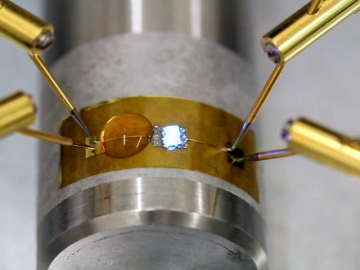
Self-Reconstructive Metal Wire: New Innovation in Nanotechnology

Device Demonstration: A device with a LED chip placed on top is attached to a polyamide board. 3 volts of electricity are applied to the board and initiate self-reconstruction.
Copyright : Waseda University
Professor Eiji Iwase (Faculty of Science and Engineering) and 1st year graduate student Tomoya Koshi (Graduate School of Fundamental Science and Engineering) have created a metal wire that can reconstruct itself utilizing electric field trapping of gold nanoparticles.
The reconstructive ability achieved in this research is expected to impact the hard-wiring of flexible devices and temperature-prone substrate electronics.
The content of this research was presented at the 28th International Conference on Micro Electro Mechanical Systems (January 18-22, 2015). The research presentation was selected as an “Outstanding Oral Paper Award Finalist” and garnered much interest.
Presentation Title: Tomoya Koshi, Eiji Iwase, “Self-healing Metal Wire using an Electric Field Trapping of Gold Nanoparticles for Flexible Devices,” Proceedings of the 28th IEEE International Conference on Micro Electro Mechanical Systems (MEMS2015), pp. 81-84, Estoril, Portugal, January 18-22, 2015.
Associated links
Waseda University's article












